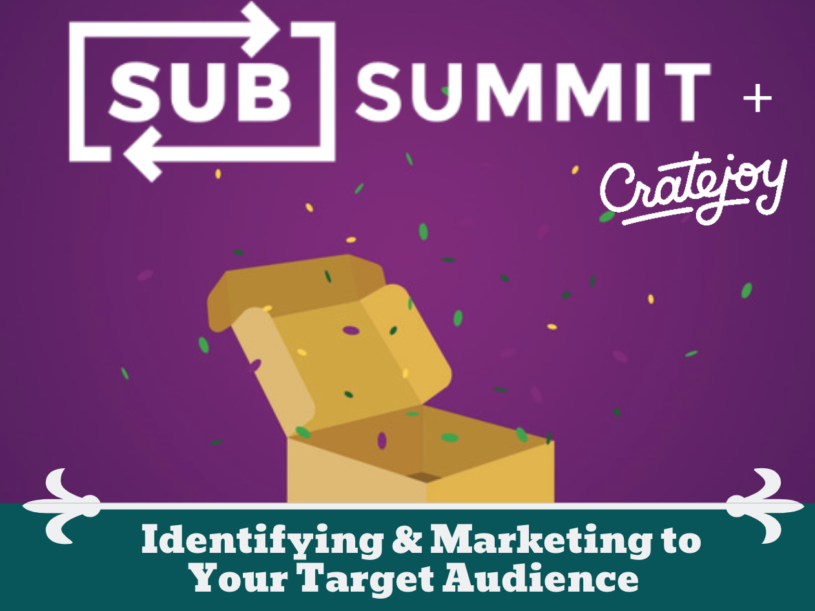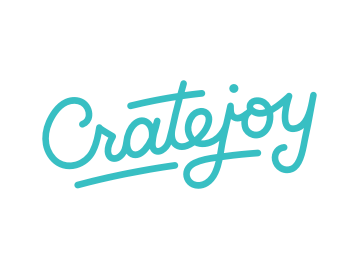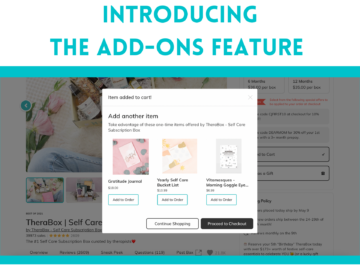When creating and running a subscription box business it is pivotal to answer the question: who is my customer?
To that end, we’re excited to show you the ins and outs of Identifying Your Target Audience, the backbone of marketing. We sat down with popular Marketplace merchants BarBella Box, Bokksu, Dapper Dog Box, and Enjoy Flowers to hear how they determined their target audience and adapted their marketing techniques as a result.
Let’s dive in, shall we?
What’s a Target Persona?
To start with, it’s not quite the same thing as a target audience (aka a “target customer”). We know that can sound confusing! Here’s the difference…
Target audiences are based on demographics and psychographics. This means not only statistical data like your customer’s age range, location, gender, race, household structure, and income bracket, but also personality data like the customer’s attitudes, opinions, and lifestyle behavior.
Target personas, on the other hand, go a step further in developing a specific, detailed profile of your ideal customer: these require a full understanding of your customer’s needs and consumer journey. You can have multiple target personas.
While you can work toward creating target personas based on what you project as your box’s value proposition and appeal to certain demographic groups, you won’t know how accurate that is until after you launch. Whatever your target personas, you will need to adapt these throughout the lifespan of your business as you grow and scale.
“Identifying your target market is important for so many reasons — it allows you to determine a brand personality, but also what types of products to include in your boxes. [I]t also helped me determine the price point of our box because I understood how much [subscribers] normally spend on fitness products monthly and how much discretionary income they have.”
Ella, BarBella Box
The founder of Bokksu, a popular Japanese snack subscription, can speak to this personally. “In the very beginning, I assumed [our target customer] would be somebody that had a strong affinity with Japanese culture and food that was in their 20s or 30s,” Danny tells us. “However, as time went on and our customer base grew, we found out that Bokksu had a broader appeal than I had originally anticipated.”
“[Our target audience] wasn’t only people that had an interest in Japan, but also people who loved to discover new foods and cultures as well as treat themselves to truly high-quality snacks every month.”
Danny, Bokksu
In this case, consumer behavior (experimenting with new foods) mattered more than static lifestyle interests (a passion for Japanese culture).
How to Use Research to Build a Persona
Luckily, we live in the age of the Internet, so there are a few different ways you could begin to research target personas. Each of our merchants did this a little differently; some began with social media and narrowed from there, while others chose to survey their existing subscribers to build a clearer picture of consumer behavior and expectations.
Unlike the other merchants we spoke with, Bokksu didn’t begin their research journey with social media; rather, they focused their efforts on niche websites. “I researched subscription review blogs, gamer blogs, [and] Facebook groups,” Danny tells us. While he also did some Googling – “for every variation of ‘Japanese snack box’” – he did so as a supplementary effort to understand the conversations going on around these keyphrases.
Dapper Dog Box, also, took a twofold approach to gather data. “We’ve garnered a ton of information from our Instagram community and used that to create personas,” Chelsee, their product manager, says. This strategy involved analyzing which of their posts had the highest consumer engagement, as well as which dog breeds showed up more in their followers’ photos.
“From there, we were able to identify dog breeds that are popular with our customers, and create personas geared toward the human customers who have those types of dogs.”
Chelsee, Dapper Dog Box
The company also surveyed their current subscribers. Using Cratejoy’s customization options in the checkout flow, Chelsee says, “we had customers fill out a survey with information about them and their dog when they purchased a box.” Once they had enough information to identify patterns, they could develop their customer personas in more detail.
Many subscription boxes, however, lean more towards one method than the other.
Use Your Subscribers to Identify Your Audience
Ella Ozery, the founder of women’s CrossFit subscription BarBella Box, had professional experience in marketing before she launched her business. For this reason, she knew exactly which steps to take in identifying her customer.
“Once I narrowed down the type of person I wanted to market to, I was easily able to do some simple marketing research (Google is your best friend!) to determine which social media channels this demographic uses the most.”
Ella
Like many Marketplace merchants, Ella found that “Instagram was a clear winner of where we should be focusing our time and money.” Additionally, the brand also uses Facebook and email marketing as their primary communication channels.
BarBella uses these channels to gather customer feedback about which products subscribers loved (and didn’t) from recent boxes. The brand’s private Facebook group for subscribers, called BarBella Family, allows them to offer support and receive feedback over years of “back and forth with our subscribers to determine their personalities, likes, and wants.”
Ella describes BarBella Family as “a place where women can share stories, discussions, [personal records], workouts, recipes, inspirational words, advice, feedback on boxes, and basically communicate with each other in every aspect of their lives.” This group is not only crucial for their team in understanding their customer, but just as crucial – perhaps even more so – for their subscribers, who have found a community around the BarBella brand.
“Before I spent the time researching our audience and figuring out their wants, I didn’t really know them… I wouldn’t have realized that these women want to be inspired and to feel like they are part of something bigger than themselves. Without that realization, I wouldn’t have understood how they want to be spoken to or what products to even include in the box!”
Ella
In contrast, monthly bouquet subscription Enjoy Flowers took a more intensive approach to researching their subscribers. “I interviewed 26 clients, selected from different groups,” says Marianna, the company’s founder. These groups, or audience “segments,” included active subscribers, churned subscribers, gift givers, and customers treating themselves. She devoted 30 minutes to conduct each client interview.
“While this was a time-consuming process… the insights were invaluable,” she tells us. Enjoy Flowers continues “to use the information gathered to make impactful improvements!”
“We also measure client behavior from paid campaigns to see if they are more interested in [flat rate] discounts or percentage discounts. We watch to see which style of messaging they respond to as well. We run A/B tests constantly!”
Marianna, Enjoy Flowers
In addition to interviews, Enjoy Flowers also uses Google & Facebook analytics to hone in on the brand’s target audience.
You’ve Identified Your Audience. Now What?
Basically… adapt your marketing strategies to accommodate what you’ve learned.
“Identifying our target audience has helped us create imagery specifically targeted to those customers,” says Chelsee. Once Dapper Dog Box learned which dog breeds were most popular with their audience, they could create ads featuring those breeds. This helps potential subscribers better imagine their experience with the box.
“People feel like they’ve come to the right place when they see a dog that looks like theirs on our website or Instagram. This has also helped us identify what influencers and affiliates to partner with to help maximize our efforts.”
Chelsee
For merchants like BarBella Box, this clearer understanding of their target audience influenced their messaging and customer communication strategies. “To determine what type of tone you want to use, it’s important to understand what you are trying to portray,” Ella explains. “In our case, once we fully understood the type of person we were marketing to, we knew that our tone needed to appeal to strong women who are looking to be inspired but also wanted to feel heard and relatable.”
Bokksu and Dapper Dog Box use Cratejoy’s reviews feature and their company’s support data to build a detailed vision of consumer needs. “We gain a lot of qualitative information about our customers from the messages they send us through email and social media,” Chelsee says. “Having a good ticketing system is essential for tracking trends in customer needs, requests, and opinions!”
In comparison, Enjoy Flowers takes an analytical approach to their customer relations. “We collect insights from Google Analytics and Facebook Analytics about ad performance and user behavior,” Marianna tells us. “After uncovering insights that pointed to medium-high household incomes and those interested in luxurious goods as audiences who would prove profitable for a flower subscription box, we tested strategy and messaging out to test this. The new communication converted well!”
Final Takeaways
All the merchants we interviewed for this panel agree on one point: identifying your target audience is a continual, evolving process.
“Though it is possible to grow your business to a certain level before needing to identify your target audiences, it will become crucial and will save you a ton of money in the long run if you identify your target audiences as soon as possible,” Danny says. As your business grows, you may encounter “shifts or changes,” so you should habitually evaluate your personas for accuracy and re-identify your target audiences as needed.
“Start somewhere and start now. How you conceive of your target audience will grow and change over time, but if you haven’t done anything to identify your audience you are throwing money away.”
Chelsee
Marianna offers tactical advice for the process of narrowing down your customer personas. “Test different, specific segments and audiences based on your unique product characteristics,” she recommends. As you accumulate learnings, you can adjust your value proposition or product offerings, then test again. “[D]rive marketing efforts to the ones that work and let go of the audiences that don’t convert.”
“Always A/B test! This will show you which path to invest in. Learn what your customers want, then tell them what they want to hear.”
Marianna
In contrast, Ella sees this type of work as inherently connected to the foundation of your business. “If you haven’t identified your target audience, you most likely don’t have a written-out business plan either,” she suggests. “If you are still in your planning phases, create a business plan right now and wait to launch until you have that in writing.”
“Sitting down and creating a business plan answers so many questions you didn’t even know you needed to know… This will help you make the necessary tweaks to your business to grow and scale efficiently.”
Ella
If you’ve launched already, Ella assures us, “it’s not too late to put a plan together.” Once you commit to developing a business plan, target audience, and strategy to reevaluate these, however, you’ll have the foundation you need to grow your business and adapt to subscribers’ changing needs.
Want more?
Download a PDF of the full interview with these merchants here, then take a look at our other SubSummit panel discussion here.



